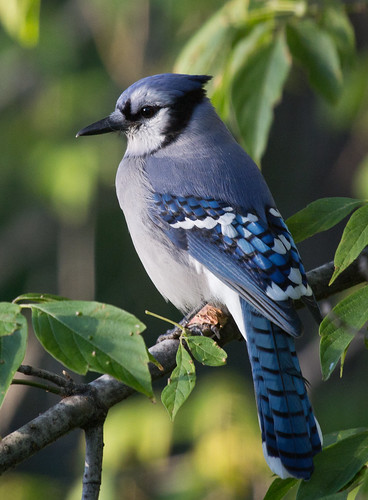At 7:37 Central Time on Saturday morning, March 31, the moon will be full. As the second full moon in the month of March, it qualifies as a blue moon. And once in a blue moon, I am personally committed to honoring Blue Jays with National Blue Jay Awareness Month.
Why Blue Jays? These birds have a vivaciousness, intelligence, curiosity, and beauty unmatched in the bird world. Of course, every bird species’ qualities are unmatched in the bird world, because every bird species is unique. Blue Jays happen to have been Mark Twain’s favorite bird, or at least the only species about which he wrote a short story, “Baker’s Blue Jay Yarn.” And for myself, I cannot hear a Blue Jay squawk without being pulled out of whatever mundane task I’m embroiled in, giving me a moment of emotional and mental escape into the natural world.
It’s very easy to forget the many ways our own species is enmeshed in the natural world. If you have any doors, window trimmings, or furniture made of oak, you can thank Blue Jays, who as the last glaciers retreated planted acorns. These heavy seeds would simply drop to the ground beneath oak trees if not for squirrels carrying and burying them a bit farther, and for jays, which can cache them miles from the parent oak tree. That is why oaks started growing along the glacial melt lines years before wind-blown seeds had a chance.
Many of your backyard songbirds depend on Blue Jays, the powerhouses running avian neighborhood watch programs and serving as the noisiest alarm system when a snake, cat, fox, or other predator appears on the scene.
Blue Jays impact the natural world in ways that we can’t begin to understand and appreciate—we haven’t even figured out their basic migration system yet! This everyday bird, large and vivid and noisy enough to make even non-birders take notice, is just one of over 10,000 species of birds on this planet that each have a critical role in nature’s web.
Once in a Blue Moon, I like to remind people just how beholden to Blue Jays we are. I’d love to call that kind of specific attention to Le Conte’s Sparrows, Bobolinks, Blackburnian Warblers, Upland Sandpipers, Sharp-tailed Grouse, and every other species we take for granted, whether or not we’re even aware of its existence.
At a time of such unique political divisiveness and strife, when our clean air, water, and soil are under siege and people are warring about everything from guns to immigration to science to climate change, it’s good to remember that long after we’ve either used our brains to solve our problems or our weapons to end them for good, the earth will keep on keeping on. Whatever happens to those of us who are only human, Blue Jays are here to stay.
The more I read the paper, the less I comprehend
The world and all its problems, and how it all will end.
Nothing seems to be lasting. But that needn’t be so hard.
We’ve got something permanent right here in our own backyard.
It’s very clear—Blue Jays are here to stay.
Not for a year, but ever and a day.
Those Russian hackers, and NRA spokesmen, and social media that we know
May just be passing fancies, and in time may go.
But oh, my dear, Blue Jays are here to stay.(you can hear the California Ravens singing the song here)
Together we’re going a long, long way.
In time the Donald will tumble.
Trump Tower will crumble.
They’re only made of clay.
But Blue Jays are here to stay.

